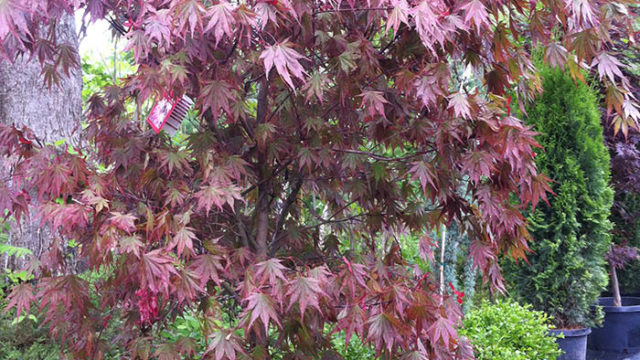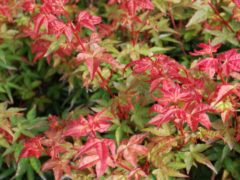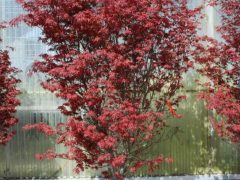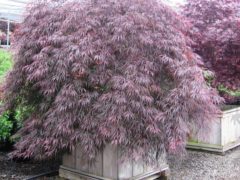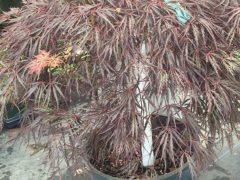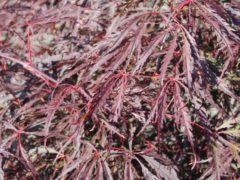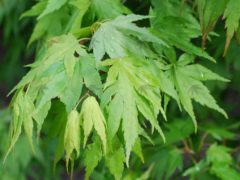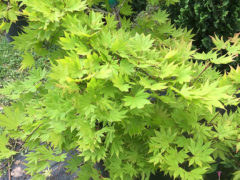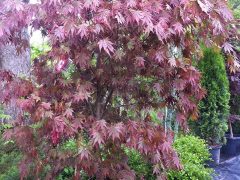Japanese maples havs been cultivated in Japan for centuries and in temperate areas around the world since the 1800s. They provide a striking focal point. Whether in the garden bed or in a large container, there are hundreds of Japanese maple varieties that come in various sizes with a large assortment of leaf shapes and colors that range from shades of green to orange, red, purple, and variegated.
Japanese maples are understory trees hardy in zones 5-8. Heat is a consideration for its effect on leaf color, causing many purple or red-leaved varieties to turn green in summer.
Providing the right amount of light is a balancing act. Too much sun can damage delicate leaves, but too little, and some of the more colorful varieties will take on a greenish tone — still nice, but not the brilliant reds and purples that are ideal in some cultivars. For best color, most maples need a location with part sun preferably in the less hot morning hours.
Most Japanese maples grow at a slow to moderate rate of 1 to 2 feet per year. They typically grow fastest when they are young and slow down as they reach maturity. Planting them in a spot where they are happy and caring for them well helps maximize their growth rate. If you want an established look right from the start, plant an older, larger maple rather than a young one that may take years to mature.
Many of the smaller varieties are excellent in containers. Japanese maples “self stunt,” meaning their top growth will decrease when their roots are confined. When planting in a container, it’s a good idea to use small to medium varieties or dwarf forms.
Water well at planting and regularly going forward. Although they can endure periodic dry spells once established, avoid extremes and water regularly during drought. Maples need mulch to protect their roots from heat and cold, and to hold moisture in place, especially for those in containers. Keep mulch away from the trunk.
Low-nitrogen fertilizer is great for spring feeding (N-15 or lower), but should not be applied after May to maximize fall color and winterizing. It’s best fertilize Japanese maples beginning with their second growing season.
Container trees should be fed more often, and heeled in to a thick mulch in a protected area each winter. It is best to root prune trees in containers every few years.
Japanese maples offer plenty of diversity, and we offer a selection of our favorites. They are listed here by height, from small to tall:
‘Beni hime’ Japanese maple
Acer palmatum 'Beni hime'
A dwarf, shrubby tree with small, rounded star-shaped leaves. New growth is pinkish red with red margins and green veins. Remains both red and green through summer becoming more intensely red and purple in fall. Small, upright trees grow 3-6' tall and 4' wide.
‘Skeeter’s Broom’ Japanese maple
Acer palmatum 'Skeeter's Broom'
New growth on this compact Japanese maple emerges a lovely bright red. As the foliage matures it takes on more of a burgundy color. Small, slow-growing, upright trees grow to 6' high and wide in 10 years.
‘Tamuke yama’ Japanese maple
Acer palmatum dissectum 'Tamuke yama'
A rich red-purple weeping laceleaf that holds its color well through summer. Leaves emerge slightly redder and fall color is brilliant red. Grows comparatively quickly to maturity of 6-8' high and 8-12' wide.
‘Crimson Queen’ Japanese maple
Acer palmatum dissectum ‘Crimson Queen’
This threadleaf Japanese maple has finely cut foliage and cascading habit. Dark magent-purple color is best with some sun. Needs protection from wind to prevent leaf tattering. Grows 6-8' high and 10-12' wide with a weeping habit.
‘Inabe Shidare’ Japanese maple
Acer palmatum dissectum 'Inabe Shidare'
This laceleaf maple sports rich maroon foliage with a cascading habit that is a bit more upright than most. Color is a brilliant crimson in fall. This variety is faster growing than other red laceleafs to 10' wide and 7' tall.
‘Tobiosho’ Japanese maple
Acer palmatum 'Tobiosho'
Five-lobed, medium green leaves with red petioles and veins turn bright red in the fall. A medium, upright, rounded tree that grows 15-20' high and 10-15' wide.
‘Autumn Moon’ Japanese maple
Acer shirasawanum ‘Autumn Moon’
Spring foliage emerges an unusual pink orange color with an underlying shade of chartruese green. Leaves have many more lobes than a palmatum, giving them a rounded appearance. Fall color is a rich orange and red. Tis small tree tolerates heat well and grows to 12’ in 10 years. Will ultimately reach 20' high with a 15' spread.
‘Bloodgood’ Japanese maple
Acer palmatum 'Bloodgood'
A vigorous, upright habit with blackish-red new stems and large deeply cut red leaves that change to brighter red in fall. This is the iconic red upright Japanese maple to which all others are compared, and we think it is the most adaptable and easy to grow. Mature specimens can reach 20' high and wide.
